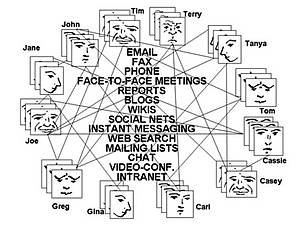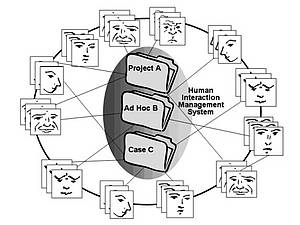With all the hype around Web 2.0, it’s time to take a second look at how such technologies can be harnessed to help people work better together instead of hammering them with information overload. In this article we’ll explore the need for Human Interaction Management and Human Interaction Management Systems to capitalize on new technologies labeled “2.0” for innovation through collaboration. ______________________________________________________________________
Are you getting a little tired of 2.0 this, and 2.0 that? Web 2.0? Enterprise 2.0? BPM 2.0? Office 2.0?
In the race to create a new alphabet soup recipe for the IT industry, we have the new ingredients of business versions of RSS, Wikis, Flickr, Myspace, LinkIn, Second Life, YouTube, IM, Presence, VOIP, Tagging, Blogs, MashUps, and so on. Oh my, are we having fun yet? They are all supposed to help us collaborate, right? And, collaboration is the secret sauce of innovation, right? And innovation is the holy grail of competitive advantage by “co-creating” value, right? And that’s what any company must do in the new world of total global competition, right?
Right. Yet, with all the opportunity to interconnect far-flung business resources, people and systems, “ThisAndThat 2.0,” also poses an immense challenge in that the humans, the very heart and soul of any company, can be overwhelmed by the sheer amounts of information that can flow through the new worlds of ThisAndThat 2.0.

Information Overload from ThisAndThat 2.0 Connections(A real mess)
What’s really needed is a World Wide Workspace for systematic and well-managed human interactions, as opposed to the out-of-control ThisAndThat 2.0. Indeed, something is missing in the current crop of ThisAndThat 2.0 – direct and formal support for dynamic human-to-human interactions that demand “human work context,” not an “IT ThisAndThat 2.0 context” that essentially centers on making connections. It’s managing those connections in a human work context that makes for effective collaboration. Humans work on projects, undertake case management and enter into ad hoc collaborations that are all goal oriented, not simply connections oriented.

Collaboration: Adding Structure to ThisAndThat 2.0 Connections
In an email leading up to Microsoft’s annual CEO Conference last year, Bill Gates wrote, “To tackle these challenges [of information overload], information-worker software needs to evolve. It’s time to build on the capabilities we have today and create software that helps information workers adapt and thrive in an ever-changing work environment. And a new generation of software is an important ingredient in making this happen. The tools that information workers use must evolve in ways that do not add new complexity for people who already feel the pressure of an “always-on” world and ever-rising expectations for productivity.”1 Meanwhile IBM is playing catch up with Microsoft by retooling Lotus with everything 2.0. And, of course, there’s Google with its growing 2.0 offerings. Businesses are fully aware that they need big-time help in improving workplace collaboration. And they know good ole email isn’t the answer to building and operating in multi-company “innovation networks.” Nor is it the answer for co-creating value with customers, where each and every customer can tailor a company’s core offerings into unique experiences. But the onslaught of new IT vendor ThisAndThat 2.0 monikers, including SharePoint, QuickPlace, Connections, JotSpot, SameTime, et al will do little but thicken the ThisAndThat 2.0 alphabet soup.
These many IT vendor initiatives seem intent on providing the tools needed to organize human activities around information while, at the same time, taming information overload, and taking on information chaos. But is that enough?
No, it’s not enough to organize human activities around information—it must be organized around the work itself. In the Industrial Age human activities were organized around the assembly line; and in the Information Age human activities are organized around information (the raison d’etre for functional management). In the emerging Process Age, where a company’s business processes are key to effectiveness, it’s now time to organize human activities around the work itself. That means fusing traditional collaboration and information tools and extending them with a complete theory of human work if we are to build systems that can support the way people actually work, versus treating them as cogs in a ThisAndThat 2.0 information machine.
Before we can construct a universal way to describe human-driven processes, we need to impose some order on the apparent chaos of human activity, and seek the fundamental properties of human work. The search must lead us to ideas from biology, organizational theory, social systems theory, cognitive theory, sociology, and psychology. The properties and patterns we discover from these diverse disciplines will guide us in the development of a full process description framework.
Indeed, to harness ThisAndThat 2.0 for business innovation and transformation, breakthrough thinking and new systems will be needed to provide the “work context” that humans need so that they are helped, and not hindered, by the onslaught of ThisAndThat 2.0. That new way of thinking is Human Interaction Management (HIM), and the technology needed to harness ThisAndThat 2.0 for helping people work better in the wired, flat world of global business is the Human Interaction Management System (HIMS).
Human Interaction Management is not concerned with the individual, detailed tasks of an interaction worker – writing a blog, making a new entry in a Wiki, firing off an instant message, or giving a webcast. Instead, HIM concerns the higher level processes that give our work shape and structure. HIM is a way of thinking about human-driven processes that allows controlled management of change – something that is innate in all interaction work. The formal underpinnings of HIM allow the modeling of human work processes – of capturing them formally – that can allow us to support those processes properly with software. Software support is not essential, but makes it far easier to participate in, measure, and facilitate processes that not only involve multiple players, but also evolve continuously throughout their lifetime. The key is that innovative and collaborative processes used by humans mean that humans don’t work alone; they interact with one another, often in teams scattered across the globe. It’s precisely those human interactions that have not been fully addressed during the first 50+ years of using IT in business.
Although formal underpinnings should not be visible to business users of any technology, it’s those very underpinnings that enable systems to work under the stress of the real world problems they are intended to solve. For example, who cares that today’s database systems are underpinned by relational algebra? But that mathematic underpinning is indeed what makes today’s information systems solid, reliable and scalable. So too, the Human Interaction Management System needs formal underpinnings that include role-activity theory, Petri nets, Pi calculus, Z notation first-order predicate logic, speech acts, conversations for action, autopoiesis, and other foundations drawn from cognitive theory, psychology, learning theory, biology and social systems theory. Whew! Again, the underpinnings should be hidden away for the business user, but they are essential to the Human Interaction Management System’s ability to handle the true dynamics of human interactions. In short, a complete theory of how humans actually work must underpin Human Interaction Management Systems.
In the pursuit of the holy grail of innovation and the co-creation of value with customers, the process-managed enterprise will dominate by implementing radically new means of support for human interactions. Winning companies will deploy innovative information technology tools to manage human-driven processes, capture information deeply personal to each participant, and help them use this information both individually and collaboratively. With a new breed of software, the Human Interaction Management System, smart companies will be able to optimize the human-driven processes that are, in the end, their people’s jobs – and the next source of competitive advantage.
Human interaction management permits suppliers to establish a fundamental integration with the needs of their customers, by engaging directly with the human-centered processes for which their products will be used. In the twenty-first century, where customers are bewildered by choice and seek understanding from a supplier as well as low price and efficient delivery, such integration will be a necessity. Customers will find a supplier that they trust, engage with them, and stick with them to co-create value. Anyone can compete in this heady new world – but to keep the customers you gain, you need human interaction management to provide transparency and direct participation in your business processes by your customers.
After fifty years of humans being enslaved by their computer systems, computer systems now need to support humans in the complex work they carry out in an increasingly complex business ecosystem. Just consider the last wave of enterprise systems, Customer Relationship Management (CRM). Their 80% failure rate is well known, and it’s clear that sales and marketing humans were pushed over the top by having to get their work done, and also having to feed and care for these CRM beasts. Revolt! Even the man most associated with CRM systems, Tom Siebel, pronounced that “CRM is dead.” Long live the business processes that actually support customer relationships, and those are human-driven processes.
Now is the time for companies determined to dominate their industries in the decade ahead to embrace the future of process support, human interaction management. As reported in Information Age in the UK last month, “A new generation of people-centric collaborative information management tools is set to produce the first fundamental advances in personal productivity since the arrival of the spreadsheet.” After fifty years of computer-driven drudgery, companies increasingly need CIOs who are conceptual, strategic thinkers that can provision the needed capabilities for human interaction management.
HIM is the killer app for ThisAndThat 2.0. HIM is also the foundation for business innovation in the 21st century.
# # #
1 From: Bill Gates | Sent: Thu May 19 10:55:42 2005 | To: (Microsoft customers) | Subject: The New World of Work

















